TUNING
STANDARD

"SCORDATURA"
Other Tunings aims have been to re-inforce tonal function. Classical examples include the 6th string tuned to D or F, 5th to G or B, 3rd to F sharp.
OTHERS
Not to exceed a half tone above nor a tone below for reasons of sustain except for the 6th string which may go down to C. The possibility of micro intervals exists. If one wants to change the tuning in the course of performance it is advisable to lower the pitch.
All the following is worth for the standard tuning of the guitar.
FINGERING/
SYMBOLS
Right hand:
Pouce(p), index(i), majeur(m), annulaire(a), auriculaire(e)
Left hand: Fingers: 1,2,3,4
Numeration of the frets: I,II,III,IV,V etc
Numeration of the strings -circled:1,2,3,4,5,6
RANGE
Standard

BEYOND THE FRETBOARD (See Hyper Treble)
WRITING
Few general rules can be given.
1) CHORDS
All the intervals are generally possible on the condition of being less than a 10th redoubled.
Beyond this interval the bass note must be open. With two voices the high note could be harmonic

This rule applies equally to arpeggios, broken and held chords.

Avoid stacked seconds except if one of the notes is an open string or if it is a matter of two major seconds. Avoid equally seconds in the high trebles (above D on the 1st string). Be careful about tightly bunched chords and dissonant chords with 4 or more sounds.

Chords of stacked thirds are difficult beyond two except for a major 7th chord.

Beyond 4 sounds there are not enough fingers on the left hand! And these chords are possible only by use of devices like a bar and above all open strings. Simple rules do not exist to say if a chord of 5 or 6 sounds is possible.
For close chords in the bass one can formulate a law:-
A NECESSARY BUT NOT SUFFICIENT CONDITION FOR A CHORD OF "n" SOUNDS IS THAT THE TOP NOTE IS AT LEAST AS HIGH AS THE OPEN STRING OF WHICH THE NUMBER IS GIVEN BY THE FORMULA :7- n

2) POLYRHYTHM & COUNTERPOINT
Having analysed the problems of intervals, problems of independence of the parts are posed. Broadly speaking it is possible to play on the guitar anything that could be played on the PIANO WITH ONE HAND (provided the music is free of the problems of intervals or distances on the keyboard). Examples:
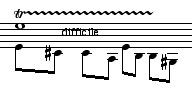
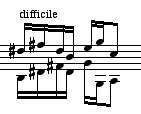
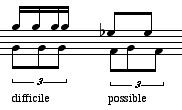
3) REGISTRATION
On the guitar, the thumb being the best digit on the right hand with mobility and depth of sound, the centre of musical interest is often focussed on the bass strings. This is moreover, the region in which there is the best sound output and greatest espressivity of the instrument.

Likewise, contrary to well known laws of harmony, some chords can sound very good on the guitar in unorthodox positions (and vice versa):

SPECIFIC EFFECTS:
HARMONICS
Table of NATURAL HARMONICS:

These can be doubles or triples. With a bar, three chords of six sounds are possible.
Speed of execution is limited to about 80/90 to the crotchet (playing semiquavers).
ARTIFICAL HARMONICS: Simple harmonics are possible at the octave of the fingered note and these can be accompanied by a bass.
Register:


One can also, in return for a deviation of the left hand, obtain NATURAL HARMONICS on stopped notes. With this method one can slowly but very correctly sound the octave harmonic and with more difficulty the double octave.

PIZZICATO
Very short in the treble these are especially effective in the bass (an effect like double bass). Possible in chords but only with close intervals.

Likewise in arpeggios of three and four notes (very rapid if ascending).

Speed of separate pizz normally limited to 90/100 to the crotchet (playing semiquavers). In runs one can augment this speed by resting the little finger of the right hand on the played string near to the bridge.
GLISSANDO
Range within that of each string.
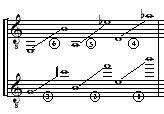
Within the limits of each string all the intervals are possible for a single glissando.
For two, three or four voices the intervals must remain parallel.

It is necessary to distinguish between a rapid glissando like mewing, and a slow glissando which allows perception of the half tones traversed.
TRILLS
Two sorts of trills exist.
The classical trill of string instruments, less brilliant on the guitar, can be played in a restrained manner.
A trill can be played on two strings which is in reality a rapid playing of a second interval. The resonance of one string on the other produces a sensation of echo. Provided that these trills can be accomodated by the left hand (one of the two notes an open string for example) they can produce a fuller sound. Notably there is the possibility of double trills limited to a maximum speed of 10 per second.

TREMOLO
In general the upper voice is sustained.

An inverted tremolo ( in the bass) is possible.

Maximum speeds:-
Upper tremolo crotchet = 110
Inverted tremolo quaver = 130
"NEW"
SOUNDS
and the way they can be played.
I have endeavoured to classify these sounds according to criteria important to new music, music of the 70s, notably "spectral" music, giving typically great importance to the ratio "noise"/"sound", starting the classification by "pure" and ending by "noisy" sound. click to listen to the "new" sounds
ATTACK & REVERBERATION
Reverberation already exists naturally for the first two open strings just as for some favoured notes of the guitar. For the others it is a matter of resting a mute finger on another string which will give the octave, or, better, the stronger 5th to the bass of the note that one normally plays. In this way a certain reverberation can be produced.
Two effects are possible.


In the second there are oscillations of micro-intervals of F, one around the other.
MULTIPHONIC SOUNDS
This is a technique to obtain two sounds more or less simultaneously from a single string. Its a matter of an open string and one of its rank of higher natural harmonics. Possible only on some isolated notes. By rapidly producing these multiphonics, two to each string, one can stack up to a dozen sounds on a standard six strings guitar.

VIBRATOS
Classical vibrato is an almost imperceptible oscillation of micro-interval traditionally assigned a role of breaking the monotony of tone. It can be broadened: 1. By stretching forcefully the string one can attain up to a quarter of tone or more. This vibrato can be slow, fast, single or repetitive and periodic with one voice or two maximum. It is very effective following Pizz.Bartok (see below)
2. WHA-WHA effect
After the emission of a note one hits the side of the right thumb on the string to obtain a remarkable echo effect which approaches the sound of throwing a bow onto the string. Notation proposed is WHA WHA. Possible only with one voice to a speed of up to eight beats per second.
MICRO-INTERVALLS

BOTTLE-NECK
With the 4th finger of the left hand equipped with a metal or glass tube one can:
1. have a clear sound from any point on the string (micro-intervals);
2. effect very long and sonorous glissandi (like the Hawaian guitar). For several voices the intervals are those of the open strings tuned to the desired pitch, even non-tempered. If the bottle neck is not held exactly perpendicular to the strings these intervals can be slightly modified.
HARMONIC ECHO
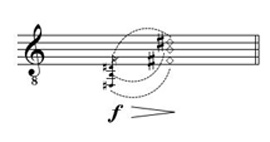
PIZZICATO LIFT
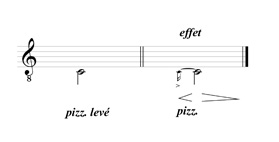
RASGUEADOS
A rotating projection of the fingers of the right hand on the strings. Origin: flamenco. Notation: RASG The shock of a nail on the string produces two sounds:
1. the principal usual sound and,
2. a much more feeble sound discernable under certain conditions. The pitch is given by the piece of the string between the bridge and the place where the right hand strikes the note. If several fingers follow in succession each will produce a different pitch and this can be varied by moving the right hand along the string. If the left hand softens or muffles the principal sound then one hears with notable difficulty a pianissimo shower of sounds of which the pitch can be as high as one wishes. The two principal rotations are fingered e,a,m,i and p,e,a,m,i. e,a,m,i et p,e,a,m,i
This last is less continuous and produces an accent to each p. It is easy only if the chord uses all the strings. RASG of four fingers is possible only on the 1st or the 6th strings and also on neighbouring strings.

Dedillo
RASG which consists of strumming the index finger of the right hand back and forth across the strings. The effect is less blended, more broken.
Rasgueado without nail
This is in fact a Dedillo executed with the pad of the right thumb and is almost without atmospheric sounds. For pianissimo sounds and for neighbouring strings.
Flick
CHORLITAZO is the traditional notation and is a RASG with a single very violent impact on a chord of at least two notes on neighbouring strings. The FLICK is the only truly sffz for a chord on the guitar.
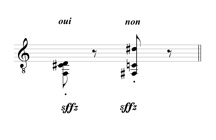
UPPER HARMONICS
The pitch, non-tempered, is given by the laws of vibrating strings. After a muffled attack their sound can be relatively clear especially on the bass strings.
STRINGS BEYOND THE FRET BOARD
The 6 strings which are fixed to the tuning mechanisms at the head can be played by either hand to produce small fixed sounds in the very high treble.
PIZZICATO
LEFT HAND
By hitting the notes without the intervention of the right hand one obtains some feeble sounds, noisy on attack but which can have a duration comparable to ordinary notes. An advantage is the possibility to combine with other sounds produced by the right hand. (see below)
PIZZ
BARTOK
HYPER-TREBLE
PLAY ABOVE THE FRETBOARD

RIGHT HAND PLAY ON THE FRET BOARD
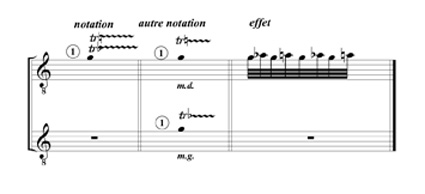
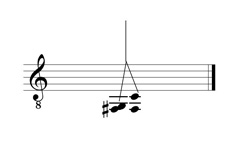
FADE OUT ENHANCED
After the attack, if one touches a string with something hard (like a fingernail), strident atmospheric sound appears which can have considerable sustain, especially where the string or the sound is long, that is to say the basses.
SLAPS
MUFFLED PERCUSSION
Typical of South American music, immediately the chord is struck (RASG) it is muffled by the palm of the right hand. This adds violence to the effect of RASG.
SLAP
A similar play but hitting the palm of the right hand on the fretboard produces a more metallic percussion giving the effect of cymbals. Can be executed on one or several strings (especially basses).
CROSSING THE STRINGS
SCRATCHINGS
PERCUSSIONS
Already utilised in the 19th century, hitting on diverse points of the body with both hands produces divers tones.
(Avoid percussion with the nails typical of flamenco because the classical instrument is not adapted for this). Notation is traditional: GOLPE. Can be executed simultaneous to the attack with the thumb of the right hand. Percussion by this digit on the strings near to the bridge gives a drum effect. Notation: TAMB or TAMBOUR.
Especially effective in the bass. Many other modes of percussion can be imagined.
ELYTRON NOISE
This is a very high buzzing that one can obtain by pushing the 6th string off the edge of the fret board between the V and VIII frets with the first finger of the left hand, and by a standard playing of the right hand. With the other three fingers on the following frets we have three quite perceptible supplementary pitches.
PREPARED GUITAR
Among infinite possiblities take two examples:
Objects under the strings, for example a little easel of paper between the strings and the table gives a very resonant rustling sound on each note.
Objects between the strings like a nail file, needle, etc.
The heavier the object the slower the period of oscillation, one then hears better the pitch produced by the excitation of the strings themselves